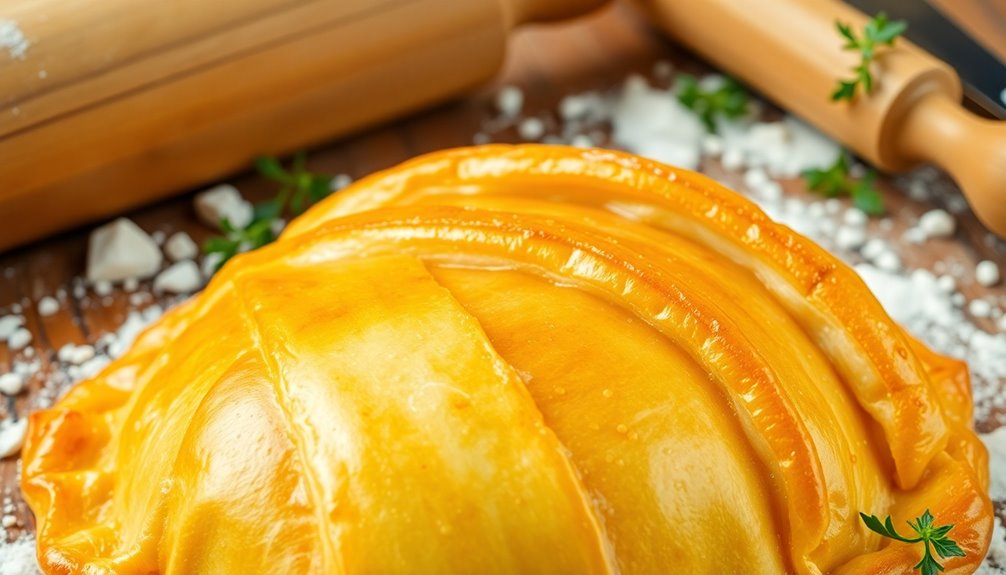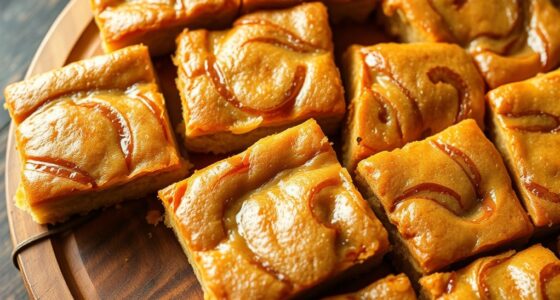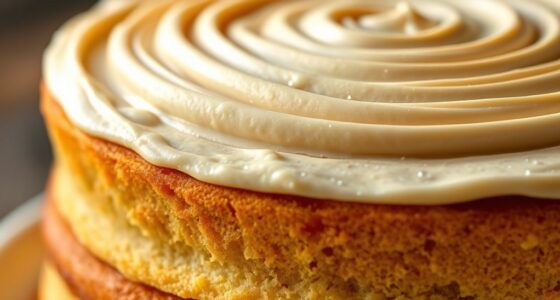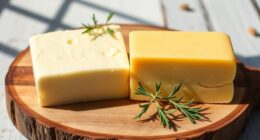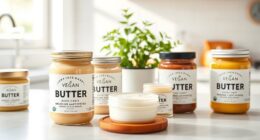To master flaky butter pastries, choose high-fat European-style butter and unbleached flour for the best texture. Keep your ingredients cold and work in a cool space to preserve the dough's integrity. Handle the dough gently, avoiding overmixing and ensuring butter remains in chunks. Aim for multiple folds during the lamination process and refrigerate between steps. Preheat your oven high for perfect rising. Stick around to uncover more tips on achieving those delicious layers!
Key Takeaways
- Use high-fat European-style butter for enhanced flavor and better lamination in your pastry dough.
- Maintain cold temperatures for butter and dough to ensure flakiness during the lamination process.
- Incorporate at least 3-4 folds while laminating to create distinct layers in the pastry.
- Refrigerate dough after each fold and before rolling to relax gluten and maintain structure.
- Preheat your oven to a high temperature to quickly set layers for a perfectly flaky finish.
Selecting the Right Ingredients for Success
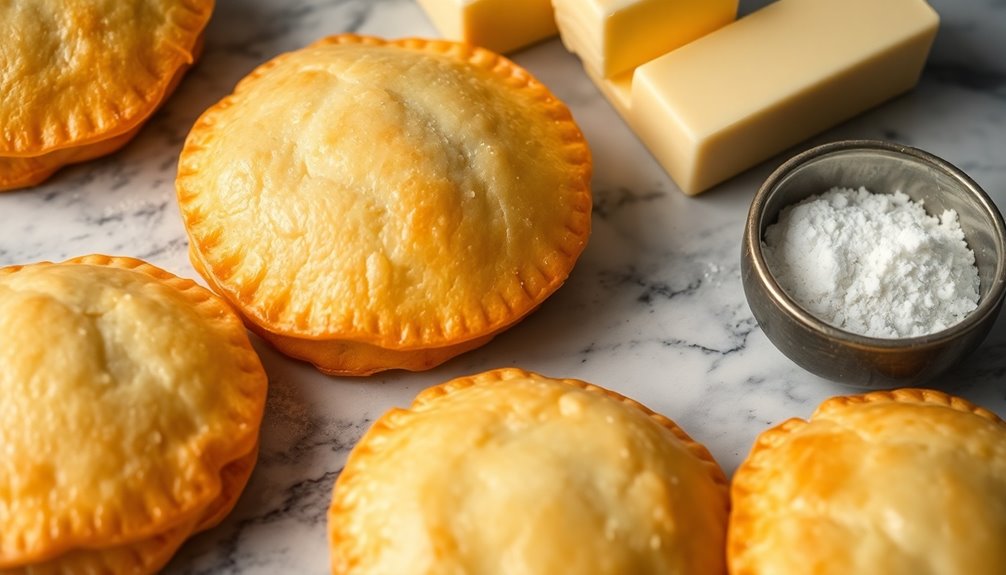
When you're mastering flaky butter pastries, selecting the right ingredients is essential for achieving that perfect texture and flavor.
Start with high-fat European-style butter, which contains 82-86% fat, to enhance flavor and guarantee better lamination.
Choose all-purpose flour or medium-strength, unbleached flour for the right gluten balance, allowing for elasticity and easy rolling.
Incorporate ice-cold water or vodka to hydrate the flour and limit gluten development, ensuring a tender yet flaky texture.
Always prioritize quality ingredients, as they greatly impact your pastry's final texture and taste.
For an extra boost of flakiness, consider blending butter with a small amount of shortening, maintaining that rich buttery flavor while creating those desirable flaky layers. Additionally, remember that moderation in butter consumption is essential for heart health, particularly due to its high saturated fat content.
The Importance of Temperature Control
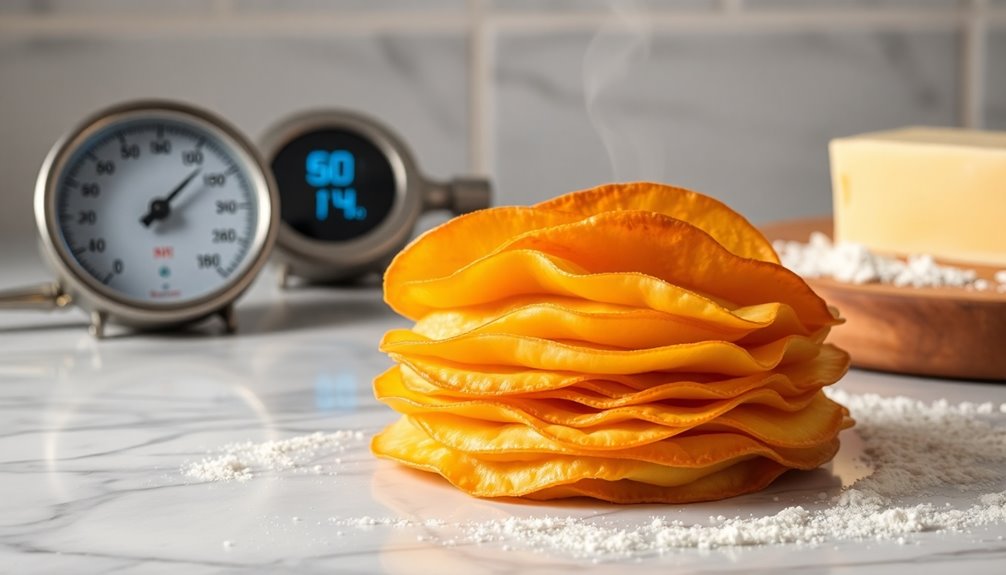
Selecting the right ingredients sets the foundation, but achieving that perfect flaky texture hinges on temperature control. Keeping your butter and water cold is essential; this prevents the fat from blending into the dough, allowing steam to create those delightful layers during baking.
Aim for your butter temperature to be between 52 to 61°F (11 to 16°C) for ideal lamination, ensuring it stays pliable yet firm. Your dough should be cooler, ideally between 36 to 43°F (2 to 6°C), to maintain structure and prevent toughness.
Remember to chill your dough for at least 30 minutes before rolling, which helps relax gluten and solidify fat. Finally, keep your work environment cool using ice blankets or refrigerating tools for better results.
Mastering the Dough Handling Techniques
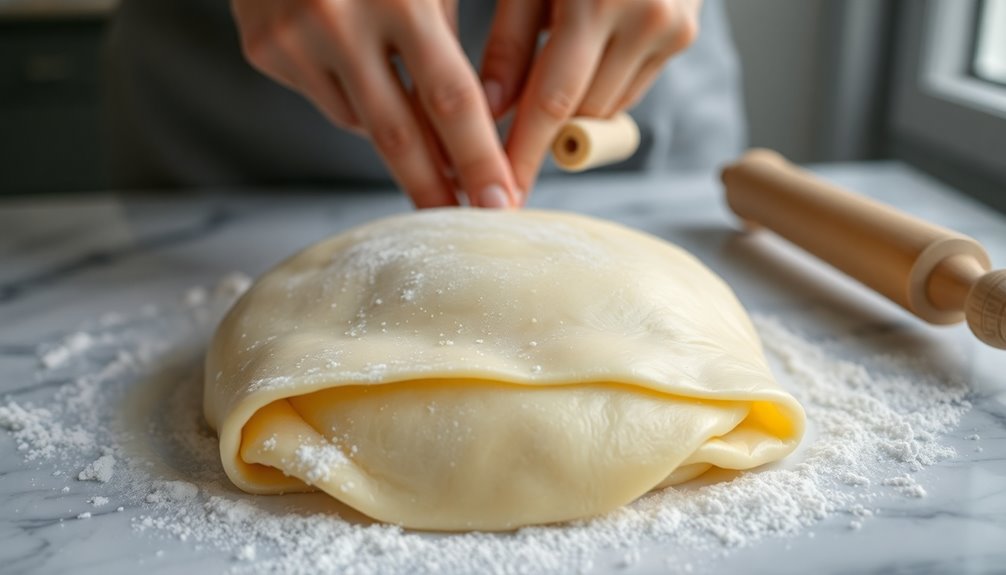
Master the art of dough handling to elevate your flaky pastries to new heights. Your dough needs a gentle touch; avoid overmixing so those visible chunks of butter stay intact. This is essential for creating steam during baking, which contributes to flaky perfection.
When rolling out the dough, keep everything cold and pliable, dusting surfaces with flour to prevent sticking. Rotate the dough frequently for even thickness.
Consider adding a splash of high-proof alcohol to hydrate the flour without developing too much gluten, maintaining that tender texture.
Always refrigerate the dough for at least 30 minutes after forming to relax gluten and solidify the fat, ensuring your layers are just right for baking success.
Achieving the Perfect Lamination Process
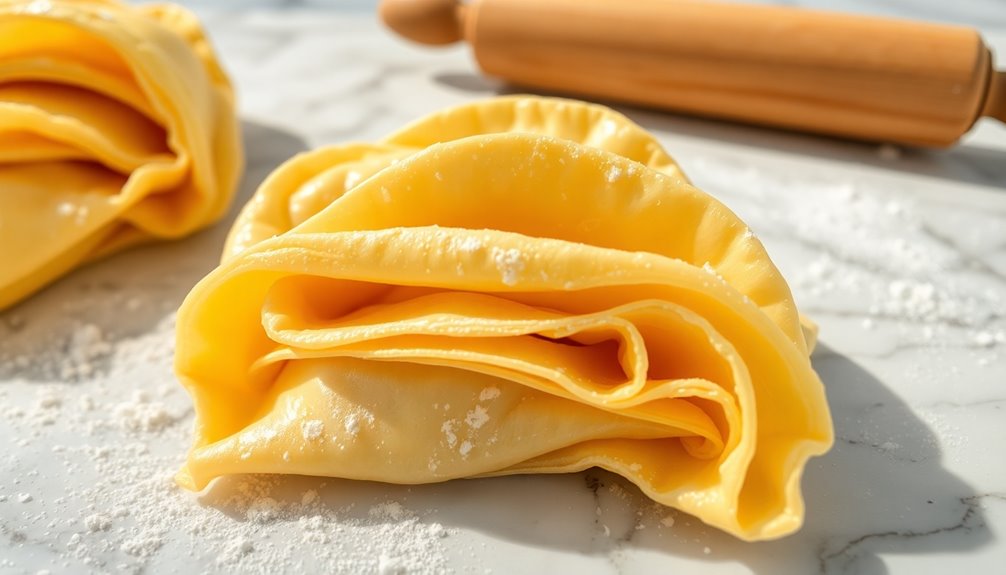
To achieve the perfect lamination process, it's essential that you keep the dough and butter at the right temperature. Keep both below 61°F (16°C) to guarantee the butter remains pliable but not greasy. This balance is vital for forming flaky layers. Aim for at least 3-4 folds during the lamination process, allowing the dough to rest in the refrigerator for 30 minutes after each fold to relax the gluten.
| Step | Action | Purpose |
|---|---|---|
| 1 | Prepare uniform butter | Prevents leakage and guarantees even layers |
| 2 | Fold dough | Creates distinct layers |
| 3 | Rest the dough | Maintains layer integrity |
| 4 | Roll gently | Avoids tearing and preserves flakiness |
Tips for Rolling and Shaping the Dough
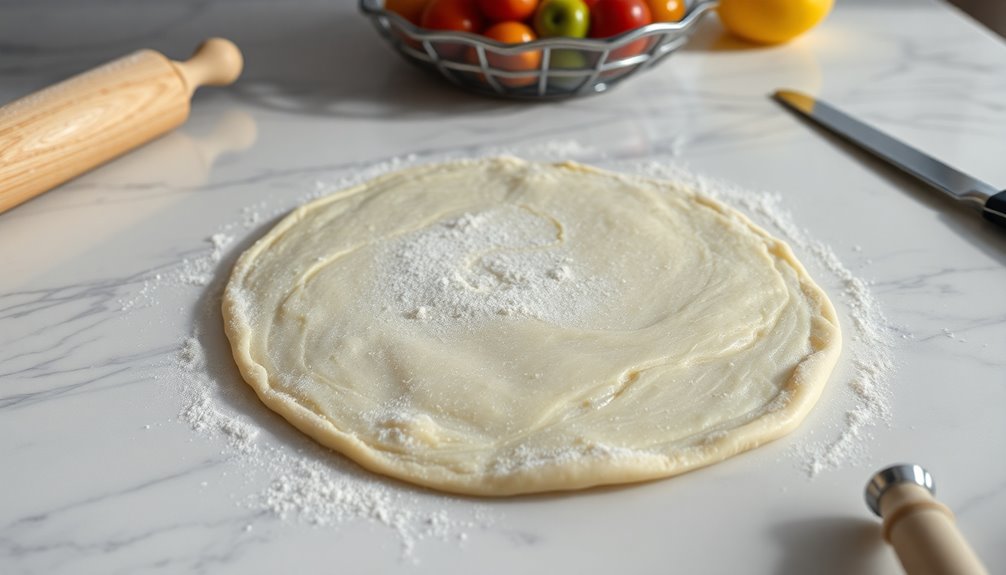
When you roll out your pastry dough, keeping it from sticking is essential for a smooth process.
Dust your work surface and rolling pin with flour, then roll from the center outward for an even thickness.
Remember to rotate the dough after each roll to maintain its shape and consistency.
Preventing Dough Stickiness
Dough stickiness can be a major hurdle in creating flaky butter pastries, but you can easily overcome it with a few simple techniques. Here are some essential tips to help you prevent sticking:
| Technique | Description | Additional Notes |
|---|---|---|
| Dust your work surface | Sprinkle flour to create a barrier. | Use a light hand. |
| Use a rolling pin | Keep it floured to avoid adhesion. | Guarantee even coverage. |
| Rotate the dough | Turn it frequently while rolling. | Access edges easily. |
| Refrigerate the dough | Chill for 15 minutes if it gets too warm. | Cold dough is less sticky. |
| Incorporate flour sparingly | Add only if necessary to maintain texture. | Avoid overdoing it. |
Achieving Even Thickness
Achieving an even thickness is vital for creating flaky butter pastries that hold their shape and texture. Start by rolling the dough on a lightly floured surface, applying even pressure as you go.
Rotate the dough frequently to guarantee uniform thickness throughout. Aim for a thickness of about 1/8 to 1/4 inch; this balance allows for ideal flakiness while being sturdy enough for fillings.
Use a rolling pin with tapered edges for better control, concentrating pressure in the center. Measure the dough with a ruler as you roll to avoid thin layers or overly thick spots.
If the dough warms up, pop it in the fridge for 15 minutes to maintain that essential cold temperature for flaky layers. Incorporating grass-fed butter into your pastry dough can enhance the flavor and flakiness significantly.
Baking Techniques for Flaky Pastries
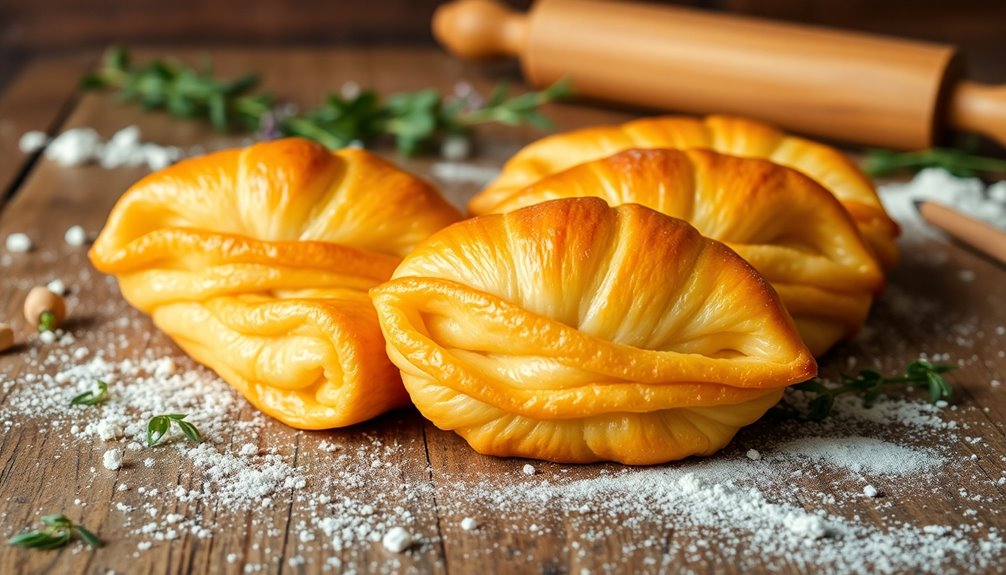
To create the perfect flaky pastry, mastering specific baking techniques is essential. Start by preheating your oven to a high temperature. This quickly sets the layers, allowing steam from the butter to create a pastry that's incredibly light and airy.
When making filled pastries, use blind baking; line the crust with parchment paper and pie weights to prevent puffing and guarantee even cooking. Remember to keep everything cold—ingredients like butter and water must stay chilled to maintain the fat's integrity.
After forming your dough, refrigerate it for at least 15 minutes before rolling out and after each lamination step. Additionally, be aware of the importance of understanding provincial vs. federal regulations when selling your pastries at local markets. Finally, brush the pastry with an egg wash before baking for a glossy, golden-brown finish.
Enhancing Flavor With Personal Touches
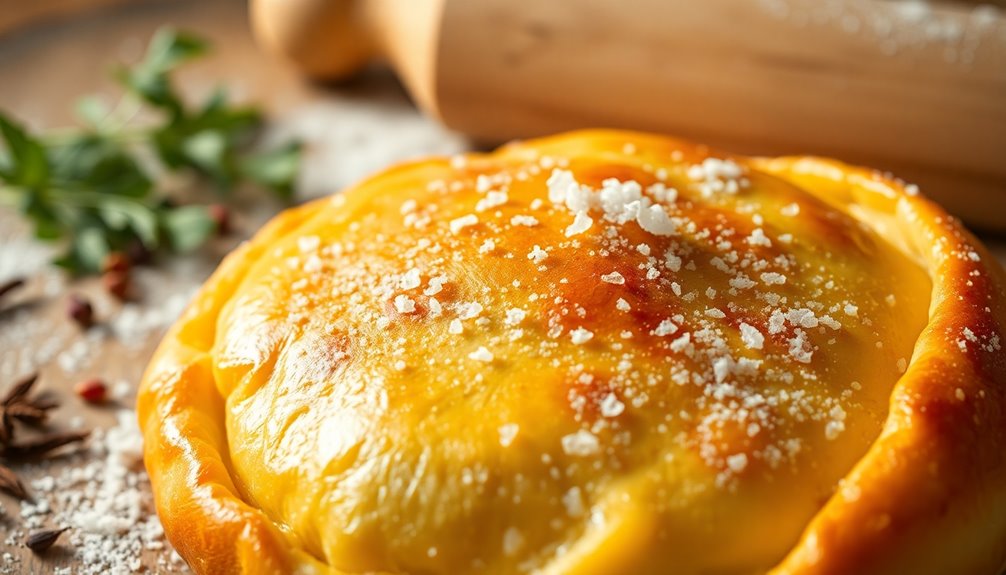
When it comes to enhancing flavor, don't hesitate to get creative with your fillings and spices.
Adding a touch of sweetness or a hint of warmth can transform your flaky pastries into something truly special.
Let's explore how you can personalize your pastries with unique flavor combinations that resonate with your taste.
Flavorful Fillings Options
How can you take your flaky pastries to the next level? Start by exploring flavorful fillings that elevate your creations.
For savory pastries, mix in fresh herbs like thyme or rosemary to bring out aromatic qualities. Consider using sharp cheddar or creamy goat cheese to add depth and richness.
For sweet options, fruit preserves or compotes can provide natural sweetness and moisture, enhancing texture. Don't forget to infuse your fillings with spices like cinnamon or cardamom for warmth.
A splash of citrus juice or zest can brighten both sweet and savory fillings, creating a revitalizing contrast to the buttery layers. Additionally, using nectar-rich plants in your savory fillings can introduce unique flavors inspired by nature.
With these ideas, you'll craft irresistible pastries that truly reflect your personal touch!
Spice and Sweet Enhancements
While many focus solely on the fillings, enhancing your pastry dough with spices and sweet elements can truly transform your baked goods.
Start by adding 1-2 tablespoons of sugar to boost sweetness and achieve a beautifully browned crust. Don't forget a pinch of salt; it balances flavors and enhances the overall taste.
Infuse your dough with spices like cinnamon or nutmeg for a warm aroma that complements sweet fillings. You can also experiment with flavored extracts, such as vanilla or almond, to elevate the final pastry's rich flavor.
For savory options, incorporate herbs like rosemary or thyme, adding an earthy note that pairs perfectly with cheese or meat fillings. Additionally, ensuring proper maintenance of your heat pump will help maintain a comfortable baking environment at the right temperature.
These enhancements will take your pastries to the next level!
Continuous Improvement in Pastry Making
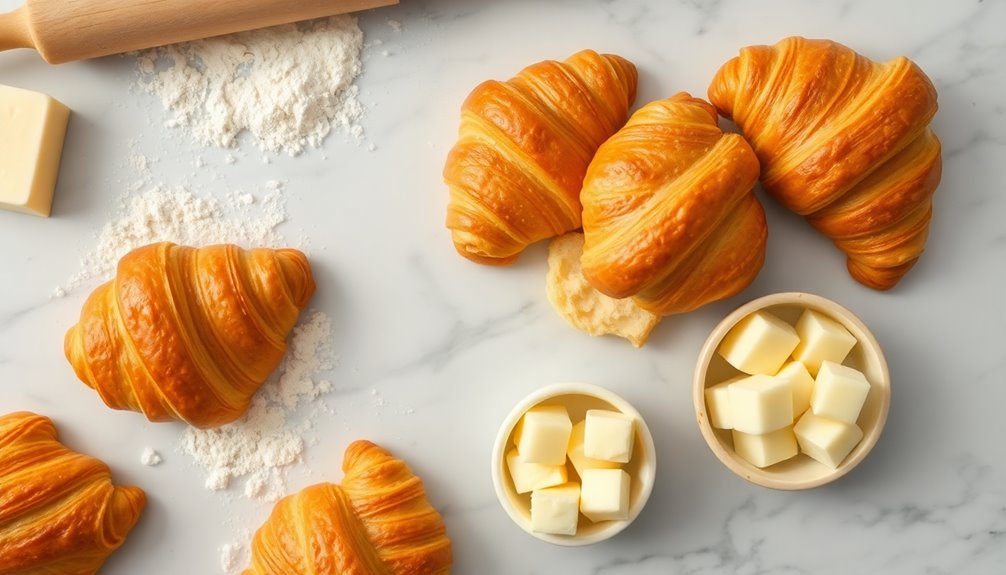
To truly master flaky butter pastries, you must embrace continuous improvement in your baking techniques. Regular practice with dough and lamination helps you understand ingredient interactions and develop texture.
Reflecting on past baking experiences allows you to identify areas needing enhancement, like dough temperature control or ingredient measurements. Experimenting with different butters or flours can lead to unique textures and flavors, pushing your skills further.
Maintaining precise temperature control during preparation is essential; using chilled ingredients and working in a cool environment greatly boosts flakiness.
Understanding the historical context of butter making techniques can also inspire you to explore traditional methods that enhance your pastries.
Don't hesitate to seek feedback from others and compare your results with established recipes. This ongoing process will motivate your growth in pastry making, ensuring those flaky layers become your signature.
Frequently Asked Questions
What Is the Secret to Flaky Pastry?
The secret to flaky pastry lies in a few key techniques.
You'll want to keep your butter cold and visible in the dough, which creates steam during baking. Use a flour-to-butter ratio of 6:5 for distinct layers.
Incorporating a splash of vodka helps limit gluten development while hydrating the flour.
Remember to chill your dough for at least 30 minutes and practice proper lamination with rolling and folding to achieve those perfect flaky layers.
How Can You Achieve a Flaky Texture in Pastry?
To achieve a flaky texture in pastry, you'll want to keep your butter cold, use a proper fat-to-flour ratio, and incorporate ice water.
You'll also need to roll and fold the dough repeatedly to create layers, and you might consider adding a splash of vodka to limit gluten formation.
Remember to chill the dough regularly after handling; it'll help maintain that essential cold temperature for the best results.
Enjoy the process!
How to Make the Best Flaky Pastry?
To make the best flaky pastry, you'll want to start with a 6:5 ratio of butter to flour.
Use chilled unsalted butter, creating irregular chunks for that perfect puff. Incorporate ice-cold water and a splash of vodka to keep gluten at bay.
Keep everything cold, roll out the dough, and refrigerate between lamination steps.
Finally, blind bake your crust to guarantee it stays crisp when filled. You'll love the results!
What Is the Golden Rule of Pastry Making?
Did you know that nearly 80% of bakers believe the key to great pastry lies in keeping ingredients cold?
The golden rule of pastry making is to keep all your ingredients, especially butter and water, as cold as possible. This prevents fat from melting too soon, ensuring a flaky texture.
You'll also want to measure accurately, avoid overworking your dough, and chill it after handling for the best results.
Happy baking!
Conclusion
Now that you've got the tips for mastering flaky butter pastries, it's time to put them into practice. Did you know that the perfect lamination technique can create up to 1,000 layers in a single croissant? That's right! With the right ingredients, temperature control, and handling techniques, you can achieve deliciously flaky results. Keep experimenting and refining your skills, and soon you'll impress everyone with your pastry prowess. Happy baking!
